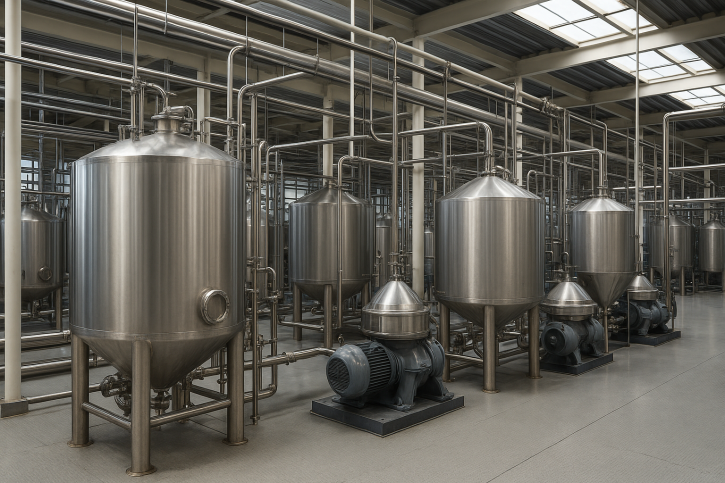Degumming in Edible Oil Refining: Processes, Challenges & Modern Solutions
The first crucial step in edible oil refining is degumming, the removal of phospholipids and other impurities that affect stability, color, flavor, and shelf life. Edible oil degumming is not just a technical requirement; it is a turning point that impacts the entire refining chain, from neutralization to deodorization. Without effective degumming, subsequent processes become more expensive and less efficient, and the oil risks failing to meet international quality standards.
Why Degumming is Essential
Phospholipids (or gums) are polar compounds present in vegetable oils. They can account for 0.5% to 3% of crude oil, depending on the feedstock (soybean, sunflower, rapeseed, palm, corn). If not removed, they cause significant issues:
- Oxidative instability: accelerate rancidity and color deterioration.
- Operational problems: foaming, deposits, and fouling in heat exchangers.
- Reduced yield: presence of phosphorus, metals, and waxes that hinder neutralization and bleaching.
- Regulatory non-compliance: strict limits on phosphorus (<10 ppm) and heavy metals.
Degumming transforms unstable crude oil into a feedstock ready for subsequent steps. It also generates lecithin, a high-value by-product used in food, nutraceutical, and pharmaceutical industries.
Chemistry of Phospholipids and Impurities
The main phospholipids found in oils are phosphatidylcholine, phosphatidylethanolamine, phosphatidylinositol, and phosphatidylserine. Their polar nature makes them insoluble in refined oils and prone to forming stable emulsions with water and alcohols. Alongside phospholipids, other contaminants are present in crude oil:
- Metals (iron, copper): catalyze oxidation.
- Pigments: chlorophyll, carotenoids.
- Protein and sugar residues.
- Waxes and sterols (particularly in sunflower and corn oils).
These impurities affect stability, taste, and color, and reduce the efficiency of bleaching and deodorization. A well-designed edible oil degumming strategy is essential to reduce contaminants to manageable levels.
Traditional Degumming Techniques
The two most established techniques are water degumming and acid degumming, both used for decades in the edible oil industry.
Water Degumming
Water degumming involves adding 2–3% hot water (70–80°C) to crude oil. The water hydrates hydratable phospholipids (HPL), making them insoluble and easily separable via centrifugation. The process is simple and economical but leaves behind non-hydratable phospholipids (NHP) that require further treatment.
Pros: simple, low cost, produces edible lecithin.
Cons: ineffective on NHP; generates emulsions and wastewater.
Acid Degumming
Acid degumming uses organic acids (citric, phosphoric) to convert non-hydratable phospholipids into hydratable forms. A subsequent water wash removes these gums. It is more effective than water degumming alone and reduces phosphorus levels to <50 ppm.
Pros: removes both HPL and NHP, suitable for multiple oils.
Cons: requires downstream neutralization; higher water and reagent consumption.
Advanced Degumming Techniques
Over the last two decades, research has led to special degumming and enzymatic methods. These address the need for stricter oil specifications and reduced environmental costs.
Enzymatic Degumming
Enzymatic degumming employs phospholipases, enzymes that hydrolyze phospholipids into diglycerides and free fatty acids. These products remain in the oil, increasing yield and reducing waste. Main advantages include:
- Phosphorus reduction to <5 ppm.
- Higher yield (less oil loss in gums).
- Lower water and reagent consumption.
Cons: higher CAPEX and OPEX, enzyme sensitivity to temperature and pH, need for specialized know-how.
Special Degumming (Superdegumming, TOP Degumming)
Processes such as superdegumming and TOP degumming combine acids, enzymes, and optimized operating conditions to reduce phosphorus to below 10 ppm, a requirement for physical refining. These technologies are crucial for oils destined for margarine, shortenings, and other sensitive applications.
Critical Parameters and Optimization
The success of edible oil degumming depends on precise control of process parameters:
- Temperature: typically 70–90°C; too high degrades oil, too low slows the reaction.
- pH: critical for both enzymatic activity and proper acidification.
- Contact time: must be sufficient to hydrate or hydrolyze phospholipids.
- Reagent dosage: excess acid leads to emulsions and reduced yield.
- Centrifugation efficiency: key to gum separation.
Modern degumming lines incorporate in-line monitoring systems (NIR, FTIR) to track phosphorus levels and optimize the process in real time.
By-Products and Market Opportunities
Degumming produces lecithin, a mixture of phospholipids with multiple applications:
- Emulsifier in chocolate, margarine, baked goods.
- Nutraceutical supplement (phosphatidylcholine for liver and cognitive support).
- Ingredient in cosmetics and pharmaceuticals.
Lecithin valorization improves both the economic and ecological sustainability of refining. In integrated plants, lecithin can represent up to 5% of production value.
Operational Challenges and Troubleshooting
Degumming presents technical challenges that require operational expertise:
- Emulsion formation: manage agitation, acid crack, and centrifuge design.
- High phosphorus residues: optimize acidification or add enzymatic stages.
- Yield losses: improve centrifuge design and dosing controls.
- Enzyme instability: control temperature, pH, and contamination.
Innovations 2025 and Future Trends
The main innovation trends in edible oil degumming include:
- Development of more stable enzymes for wider operating ranges.
- Integration of digital monitoring and predictive automation.
- Low-energy techniques (membranes, hybrid processes).
- Improved circularity through by-product valorization.
These trends address global challenges such as energy costs, sustainability, and the demand for purer, more stable oils.
Conclusion
Edible oil degumming is a decisive step in the refining of vegetable oils. The removal of phospholipids and impurities stabilizes the oil, improves quality, and reduces downstream costs. From traditional to enzymatic and special techniques, today’s solutions provide flexibility and competitiveness. The challenge for producers is selecting the optimal mix of technologies depending on feedstock, markets, and sustainability goals.
To explore the full refining journey, from degumming to bleaching and advanced purification, read the complete guide: Refining Edible Oils and Fats: Processes & Technologies 2025.
Want to learn the full refining journey, from degumming to advanced purification?

